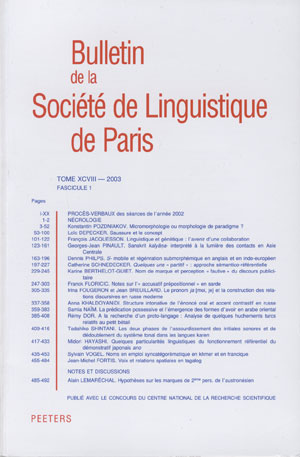 previous article in this issue previous article in this issue | next article in this issue  |

Preview first page |
Document Details : Title: L'évolution de lat. facere + proposition complétive Subtitle: Deux voies de grammaticalisation? Author(s): BODELOT, Colette Journal: Bulletin de la Société de Linguistique de Paris Volume: 113 Issue: 1 Date: 2018 Pages: 179-214 DOI: 10.2143/BSL.113.1.3285468 Abstract : L’objectif de cette étude est de retracer, à la lumière du modèle de grammaticalisation défini par Heine, Lehmann, Ramat, Traugott et al., l’évolution susceptible de conduire en latin de la séquence facere + proposition complétive aux deux constructions suivantes: 1) l’emploi quasi figé en particule de l’impératif de facere + proposition à force illocutoire directive, comme aboutissant d’une proposition avec noyau prédicatif (facere) régissant au départ une proposition complétive au subjonctif, avec sujet ou prime actant coréférentiel avec celui de facere; 2) la construction causative facere + infinitif, comme aboutissant de facere + proposition subordonnée, figurant d’abord, la plupart du temps, au subjonctif, puis à l’A.c.I., avec un agent qui reste indéterminé en cas de construction passive, mais se présente comme distinct de celui de facere à l’actif. À partir d’exemples tirés d’un corpus s’échelonnant de Plaute à Grégoire de Tours, nous tâcherons de voir si les deux mouvements s’accomplissent parallèlement et progressivement, ou si l’un connaît, par suite d’un achèvement précoce, une évolution bloquée en contraste avec l’autre. Les résultats de l’évolution latine sont susceptibles de vérification en roman. This study draws on the grammaticalization model of Heine, Lehmann, Ramat, Traugott et al. to track the evolution of the Latin construction facere + complement clause into the following two structures: (i) the particle-like use of the imperative of facere + clause with directive illocutionary force, derived from a predicative nucleus (facere) initially governing a complement clause in the subjunctive, whose subject or first argument is coreferential with that of facere, and (ii) the causative construction facere + infinitive, originating from the connection of facere with a subordinate predication, which first appears mostly in the subjunctive, then in the A.c.I., and whose agent remains indeterminate in the case of a passive construction, but differs from that of facere in an active clause. Using examples from a literary corpus stretching from Plautus to Gregory of Tours, we set out to determine whether the two developments were parallel and gradual, or whether an early completion blocked one pathway in contrast to the other. The outcomes of the Latin evolution are verifiable in Romance languages. Das Ziel dieser Studie ist es, ausgehend von dem Grammatikalisierungsmodell nach Heine, Lehmann, Ramat, Traugott et al., die Entwicklung nachzuvollziehen, die im Lateinischen von der Konstruktion facere + Komplementsatz zu folgenden beiden Strukturen führen konnte: 1) partikelartiger Gebrauch von facere im Imperativ mit einer Prädikation, die auf illokutiver Ebene eine direktive Funktion hat, wobei diese Konstruktion ursprünglich auf einem prädikativen Nukleus (facere) beruht, der einer zweiten Prädikation übergeordnet ist, die im Konjunktiv steht und deren Subjekt oder erstes Argument mit dem von facere übereinstimmt; 2) die kausative Konstruktion facere + Infinitiv, entstanden aus der Verbindung von facere mit einer untergeordneten Prädikation, die anfangs meist im Konjunktiv erscheint, dann im A.c.I., und deren Agens in der Passivkonstruktion unbestimmt bleibt, im Aktiv sich aber von dem des facere unterscheidet. Anhand von Beispielen aus einem literarischen Korpus von Plautus bis Gregor von Tours soll untersucht werden, ob die beiden Entwicklungen parallel und progressiv verlaufen oder ob aufgrund einer früher zum Abschluss kommenden Entwicklung eine der beiden im Vergleich zur anderen blockiert wird. Die Ergebnisse der lateinischen Entwicklung sind in den romanischen Sprachen überprüfbar. |
|


